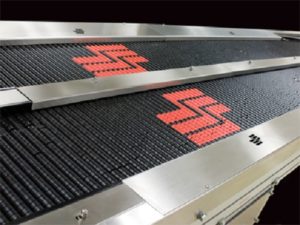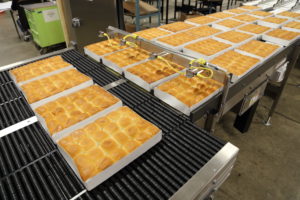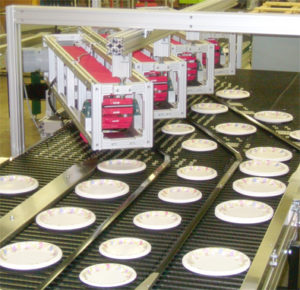Slip-Torque conveyor technology, with its very unique integration of automation and devices, has revolutionized conveyor precision by increasing filling and packaging flexibility, speeding throughput, and reducing product damage to near zero levels, even with the most delicate of products.
 There is little worse in an automated production line environment than a cessation of throughput because of equipment failure, product spillage or product jam ups. The costs of the equipment repair, product damage and clean up, and the lost employee time are marginal compared to the loss of throughput. In high-volume manufacturing plants, interruption of throughput can exceed hundreds of cases per hour not processed because of slowdowns, shutdowns, and jam ups.
There is little worse in an automated production line environment than a cessation of throughput because of equipment failure, product spillage or product jam ups. The costs of the equipment repair, product damage and clean up, and the lost employee time are marginal compared to the loss of throughput. In high-volume manufacturing plants, interruption of throughput can exceed hundreds of cases per hour not processed because of slowdowns, shutdowns, and jam ups.
Corporations are increasingly viewing their product line operations from a performance versus cost standpoint. Establishment and monitoring of key performance indicators for maintenance, safety and system uptime within the production environment has taken on a whole new perspective with an eye toward the maximum output, optimum equipment utilization and system longevity.
This perspective is nowhere more critical than with the conveyor systems used to transport and index products into the various production, filling and packaging automated systems along the line. Minimizing conveyor line stoppages significantly decreases opportunities for product jam ups and damage. By allowing the process to continue as close as possible to a steady state condition increases line efficiency and throughput profitability.
Utilizing the most optimum conveyor system for an application is pivotal for the speed of throughput and smooth performance of the line. Conveyors that are designed for use in industrial environments, for example, may not be well suited for use in food processing, completely aside from wipe-down, wash-down and sanitation requirements. Yet this is frequently the reason why food processors experience back-ups and jamming on their conveyors resulting in product spillage, damage and waste, and why products get marred by making contact with conveyor side rails.
When shrink wrapping or flow wrapping goes awry, which many end-of-line packaging systems experience, the culprit is too often that the conveyors are not designed to adequately stage the products for precise registration for infeed. The same can be said for labeling, and particularly date stamping, where the products may have to be rotated on the conveyor to a precise location to be stamped.
Equally important is maintaining the integrity of the products being conveyed. Whatever the product and process may be – pastries or pizzas with delicate toppings being moved through a filling line, glass pharmaceutical syringes being staged for feeding into a shrink wrapper, solar panels being conveyed for end-of-line packing, or pages of a book being feed into a collator for binding – the need for transporting finished products carefully from manufacturing through wrapping, labeling, packaging and cartoning with high throughput and near-zero product damage is of critical importance. But too many manufacturers are plagued with conveying equipment that is inadequate for moving delicate products through these processes.
No matter how efficient the fillers, wrappers, labelers and cartoners may be, if the line does not use conveyors specifically designed for the application then the product quality, speed of throughput and cost-efficiency of the entire production and packaging line will be compromised.
Smarter Conveyor Roller Technology for Filling and Packaging
Automated product filling and packaging require conveyor systems that provide precision product placement. Although traditional flat-belt conveyors can deliver some degree of precision placement, they are a poor choice for managing product accumulation, such as is required for staging and spacing product into these automated systems. The result is product jam ups, product damage, misfires on wrapping, wasted packaging materials such as shrink wrapping film, and resultant line slowdowns and cessations.
Fortunately, the solution for effectively managing product staging and spacing, and eliminating these production line difficulties comes in the form of smarter roller technology. One system in particular which is in broad use, and has been in a continual state of refinement over the past several decades, is called Slip-Torque®, which was developed by Shuttleworth LLC.
Slip-Torque is very interesting, in that it utilizes individually-powered, stationary rotating roller shafts covered with loose, segmented rollers, which become the conveyor surface. It is powered by a continuous chain to control the drive force of the conveyed products. When the products stop on the surface of the conveyor, the segmented rollers beneath them also stop, generating low back-pressure accumulation, and minimizing product damage. It is the weight of the product being conveyed, combined with the coefficient of friction between the shafts and the inside diameter of the rollers that provides the driving force. As the weight of the product increases, there is a corresponding increase in the driving force supplied.
Slip-Torque’s low line-pressure provided throughout the continuous-motion accumulation conveyor allows for precise product placement on the conveyor while it continues to take product flow from an upstream line for a period of time, where other conveyors would have stopped well before. A low-pressure accumulation buffer absorbs irregularities in the production flow and provides a smooth, even flow on the line.
The system allows the same conveyor to be split into multiple, independently-operating lanes if desired. For example, the middle lane can accumulate, while at the same time the right lane and the left lane can both convey, or even run in opposite directions. Each lane can act independently but is powered by only one common motor, which also reduces energy costs.
Conveyors with Slip-Torque have the ability to modulate the speed of different sections of the conveyor via a central control PLC and HMI. As products are moving down the line, the rollers at the back end of the conveyor can be moving faster than the ones at the front end of it. The products can be moving at variable speeds on different sections of the conveyor as dictated by throughput requirements. This controls the product spacing on the conveyor, keeping items such as delicate cheesecakes or fragile pharmaceutical products separated, and equally spaced, from each other to minimize product contact and facilitate infeed into packaging equipment such as shrink wrappers.
Such motorized rollers like Slip-Torque can also be used to minimize product contact while steering products into desired locations, such as employing rollers with herringbone patterns to orient products without the use of guardrails, or setting up a series of sequentially smaller roller heights to direct food products into the center of the conveyor for packaging induction, without touching any other conveyor parts. And motorized rollers with tapered corners can be used to maintain product orientation, gently and safely, as it is transported through 45-degree and 90-degree conveyor turns.
Slip-Torque technology can be used in elevated temperature applications such as hot products coming out of ovens up to 500° F (260° C) and in low-temperature applications as low as -20° F (-29° C) such as for refrigerated and frozen foods and pharmaceuticals.
Increased Flexibility and Precision with Product Control Devices
 Many conveyors used in filling and packaging lines enable the adaption of product control devices, such as product stops, pushers, and clamps that can be used to modify the flow of conveyed products. Most conveyors bring these devices in from the side or even over the top, such as would be found on belt conveyors, plastic link conveyors or table-top chain conveyors. Side-mounted devices are limited in their flexibility to control product flow because of their side-only mounting locations, and top-mounted devices are considered even less desirable by manufacturers because of safety and product contamination concerns.
Many conveyors used in filling and packaging lines enable the adaption of product control devices, such as product stops, pushers, and clamps that can be used to modify the flow of conveyed products. Most conveyors bring these devices in from the side or even over the top, such as would be found on belt conveyors, plastic link conveyors or table-top chain conveyors. Side-mounted devices are limited in their flexibility to control product flow because of their side-only mounting locations, and top-mounted devices are considered even less desirable by manufacturers because of safety and product contamination concerns.
Conveyors equipped with Slip-Torque function differently. They utilize the space between rollers to allow these devices to be mounted below the surface, reaching up between the rollers to effect more precise and flexible product motion control, without interfering with the line flow.
Product control devices can be more specifically located on conveyors equipped with Slip-Torque compared to conventional systems, and bring a much higher level of positioning accuracy with more positive product handling. Devices like: a) Blade stops and brakes that enable on-demand stops and starts of production flow; b) Lift-and-transfer, lift-and-rotate, side transfer and turntable devices are used to provide a smooth and accurate product transfer at a 90-degree angle to the original transport direction, or to change the orientation of products on the conveyor; c) Product positioners accurately position products for a particular process; d) Pushers to push products perpendicularly from one conveyor traffic lane to another traveling in the same or the opposite direction, into or out of operator workstations or off of the conveyor system completely; and e) Single-row combiners efficiently combine food products in multiple lanes into one single row.
Optimized Wrapper Infeed
Nowhere in the packaging process is the handling of the product more susceptible to damage than in the wrapper infeed cycle, resulting in high defect rates, lessened throughput and increased production costs. This is common particularly with shrink wrapping where mis-wraps can easily occur, jamming the line. When shrink coverage does not completely cover the product, it can go unnoticed until later when the product has spoiled due to exposure. Improper sealing is primarily caused by poor infeed and mis-registration.
To achieve a much more consistent level of registration and wrapping integrity, a system called Servo-SmartFeed® is now being used by many companies with automatic L-sealers, horizontal form-fill and seal-flow wrappers, and over-wrappers. Servo-SmartFeed, also developed by Shuttleworth, working in combination with Slip-Torque conveyors, links wrapper infeed to upstream product flow. It is designed to dynamically accumulate and synchronize the release of products into a wrapper or packaging machine without stopping the product flow. Products on the system are always in motion while the downstream equipment is operational.
SmartFeed operates by timing the release of product into the flighted infeed on the wrapper with a pneumatic/electric gate. With a speed-up zone near the discharge end of SmartFeed, one product at a time is placed onto the infeed of the wrapper. The spacing is very precise, a tolerance of 0.25 inch to 0.5 inch. SmartFeed is in synchronization with the wrapping machine using encoder feedback from the wrapper. A sensor identifies each product’s location, and then the conveyor will either accelerate or decelerate the product to place it into position on the flighted infeed of the wrapper.
The system operates in four speed-registration zones to manage the infeed of products: 1) the first zone accepts the product from upstream manufacturing such as a freezer, oven or staging point, then conveys it downstream; 2) the second zone closes the gaps between the product, running the food product back-to-back; 3) the third zone increases the spacing between the products equal to the pitch flight on the wrapper; 4) and the fourth zone positions each individual food item into the gaps between the flights.
The automatic wrapper and SmartFeed are always talking to each other and reacting to whatever products are moving through the line. When there is a delay with an item, SmartFeed tells the wrapper that no item is in position, and to slow down or stop. When the next item is in position, SmartFeed tells the wrapper to start, providing there is accurate indexing of the product to be wrapped.
Servo-SmartFeed creates an integrated system monitoring the flow of product right through to the wrapper. Controls installed upstream regulate the speed of the line throughout, directed by SmartFeed.
Smarter Conveyor Technology for Filling and Packaging Lines
Slip-Torque conveyor technology has evolved to a level of exceptionally high precision through decades of practical application in numerous industries. Manufacturers now have smarter conveyor systems that are specifically designed for the precision and flexible needs of filling and packaging lines. Systems that incorporate the necessary automation and product handling devices that enable companies to achieve more productivity, increased versatility, decreased product damage and realize a more profitable bottom line.
